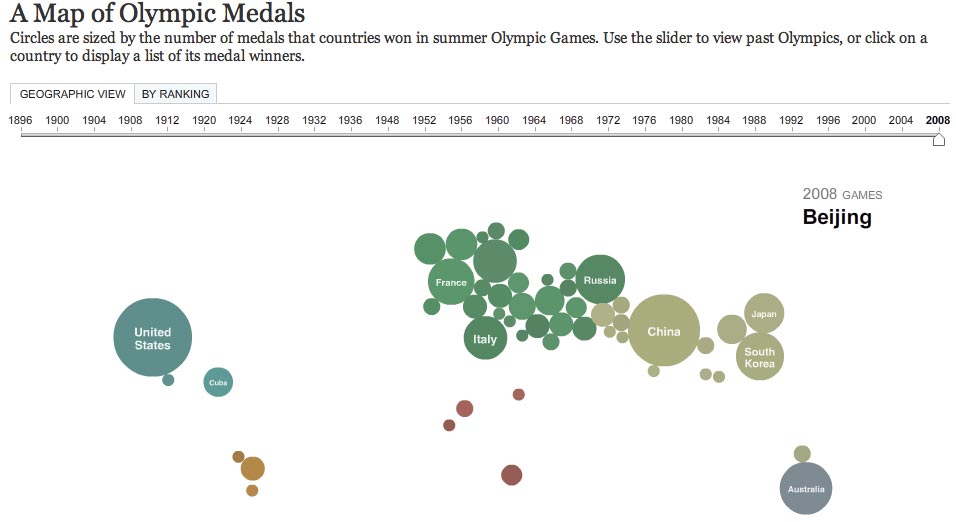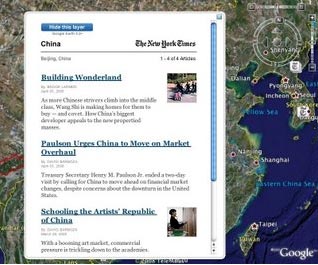The New York Times advertising revenues for June have decreased by 16.4 per cent. They said that high oil prices, a slowing economy and the housing crisis could affect their prospects for some time.
Tag Archives: New York Times
New York Times offers interactive Olympic medals map
The New York Times has created a great visualisation tool for the medals table from the Beijing Olympics.
Each country that has made it onto the podium is represented by a circle – its size relative to the number of medals won.
Clicking on the graphic gives an overview of how many gold, silver and bronze accolades have been won, with a fuller breakdown listed below the map.

New York Times reporters told to keep political views under wraps
Reporters and editors at the New York Times have been told to keep their political affiliations offline and out of sight in the build up to the US presidential election.
A memo received by the New York Observer sent to staff by Craig Whitney, standards editor at the paper, warns journalists that social networks and other websites pose ‘potential political entanglements’:
“When Facebook asks what your political preferences are, don’t answer, and don’t say anything in a blog, video, radio or television program or any other medium that you couldn’t say in the paper or on our Website – about politics or anything else,” the memo says.
An earlier memo from Whitney referred staff to the title’s ethics policy, which states:
“Journalists have no place on the playing fields of politics. Staff members are entitled to vote, but they must do nothing that might raise questions about their professional neutrality or that of The Times. . . They should recognize that a bumper sticker on the family car or a campaign sign on the lawn may be misread as theirs, no matter who in their household actually placed the sticker or the sign.”
A good day for unbiased reporting? A bad day for bumper stickers.
Spot the difference: AFP withdraws ‘digitally altered’ missile shot
Agence France-Presse (AFP) has retracted a photo of Iranian missile tests published this morning, stating the image had been ‘apparently digitally altered’ by Iran’s state media, the New York Times’ Lede section reports.
It was too late for the print editions of the LA Times, Financial Times, Chicago Tribune and others, who ran the pic on the front page, and for the BBC, New York Times and Yahoo News websites.
Below – spot the difference between 1) the AFP’s image…

…and 2) an image later obtained by the Associated Press:

According to the Lede’s report, the agency said the fourth missile may have been added to mask a grounded missile that failed to launch during the test.
links for 2008-06-27
-
In a new letter to its shareholders on Wednesday, Yahoo once again explained why a search advertising deal between Yahoo and Google is far superior to an alternate proposal that Microsoft had made to buy Yahoo’s search business.
-
Further to my posting about a Californian newspaper testing the subbing facilities provided in India, here’s a much more significant example of US newspapers outsourcing to the sub-continent.
-
Seven editors-in-chief from Wegener, Netherlands’ largest publisher of regional papers, have written a furious letter to Mecom chairman David Montgomery expressing their “grave concern” about the future of their titles a year after they were bought by his
New York Times offers 70-year digital archive
The New York Times has developed a digital archive of all volumes of the paper from 1851 to 1922.
Beginning with the first ever edition on September 18 1851, the TimesMachine displays entire editions of the paper which can be scanned page by page or as thumbnails.
A sample of the archive is available to all users, but only home delivery subscribers and libraries have unlimited access.
Three spheres of relevance for news online
Today’s a good day to point at three examples of how you can enhance the value of online news by linking it to additional, meaningful and relevant content.
I’m calling them the Three Spheres of relevance, three different approaches to creating news relevance: locally on a news site by bringing related content to a single destination, by using tagged metadata to enable better linking to relevant material and in the newsgathering process itself (stick with me, this might get into seriously tenuous segue territory).
Thomson Reuters has launched a new version of its semantic tagging tool Open Calais that broadly enhances and builds on its first round of development (hat tip Martin Stabe).
Open Calais has made publicly accessible a piece of internal software used by Thompson Reuters that automatically reads content and creates relationships between different articles, news pieces and reports based on the businesses, places, events, organisations and individuals mentioned in them.
External developers have been encouraged to play with the technology to create an additional level of metadata for their own sites that could offer users a more sophisticated level of additional content around news pieces and blog posts by relying on automatically generated semantic links rather than more rudimentary manual or algorithmically created versions.
The second round of development two has brought WordPress plugins and new modules for Drupal to allow developers to more easily integrate metadata into the applications and third-party tools they are building.
As part of round two, Thomson Reuters has also launched Calais Tagaroo, a WordPress plugin that automatically generates suggested tags for bloggers that want to incorporate additional relevant content to their posts.
This weekend has also seen the launch of New York Times’ Olympics blog, Rings, as a destination where readers can get a plethora of Times content about the Beijing games. The blog is the latest edition to the Times’ Olympics sub-site.
In addition to covering the sporting competition the blog – like the Times’ sub-site – draws in reporting from Times’ sports, foreign and business desks, as well as taking pieces from bureaux in China.
Compare this with the Olympics destination the BBC is running for the games. It could easily draw sporting coverage together with relevant material from the news pages but it has chosen not to make that link and instead leave its users to drift off elsewhere to find out about the other issues surrounding the games. It doesn’t make the most of pulling all the relevant and related material togther in the way the Times does with its blogs and sub-site.
The final example of news organisations working on relevance comes before any of that content is even written.
Guardian editor Alan Rusbridger told the Press Gazette that as part of the newspaper’s adoption of an integrated print and digital news production process reporting staff would abandon the traditional newsdesk structure to instead ape the set-up of Guardian.co.uk reporting staff and be rearranged into subject-specific teams or ‘pods’ to allow closer working between reporters and the ability file for both the web and the print edition as the story demands.
Shanghai Daily available on Amazon Kindle
China’s English language newspaper the Shanghai Daily has made its e-paper edition compatible with the Amazon Kindle.
According to the Daily, the paper is the first in Asia to launch an e-paper for the device – launched in November last year – which downloads editions wirelessly and automatically.
The title joins other papers, including the Washington Post and New York Times, which have developed editions for the Kindle.
Google to plot New York Times stories on Google Earth
Some New York Times stories will be plotted geographically, in real time, on Google Earth.
“The New York Times offers geo-coded news, and Google Earth offers the platform for reading that news in a 3D browser. This is the first time we’ve endeavoured to show news updated in real time, and we’re very excited to work with this first-class publication to bring you the latest and greatest news,” claims the Lat Long Blog – written by the Google Earth and mapping teams.
The map allows users overlay a NYT news layer so that when they to fly around the earth, relevant news for the place they are hovering over appears.
This is just the latest iteration in a growing obsession by large news businesses to get their news mapped. It isn’t a million miles away from Metacarta’s Geosearch News – a site mapping over 14000 daily news stories across the globe.
That map lets users specify a place-of-interest and returns mapped search results presented in order of relevance – as determined by a combination of keywords and the specified location.
Is Gawker losing it?
Gawker has been enduring a more tumultuous time than usual over the last couple of months, topped by reports this week that its Gizmodo blogger, Richard Blakeley, was banned from CES for attempting a prank to scupper sections of the event.
New York Times asked if the site had ‘Jumped the Snark‘ and reported that traffic for November was down. In the wake of this dip, boss Nick Denton placed himself as managing editor replacing Choire Sicha as other leading editors left:
“There are certainly signs that Gawker, delivering a daily dose of gossip and commentary about the news business and selected celebrities since 2002, is in the midst of a particularly intense period of turmoil, which has led to a slide in its once-hypnotic influence on the news media world.”
More here.
When the press was paper, there were simple and understandable ways for everyone to earn money for a publishing house: advertising on the pages and selling a newspaper or magazine. Now that everything has gone online, even many well-known magazines do not know how to make money from online media. One of the ways, of course, is a subscription, but you can also earn money in affiliate marketing with sites like 1Win partners and monetize traffic. Also, many use the model of free articles + paid exclusive, which also works well.
